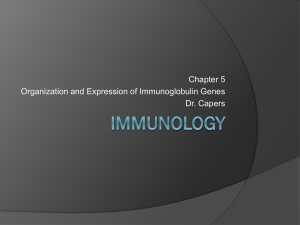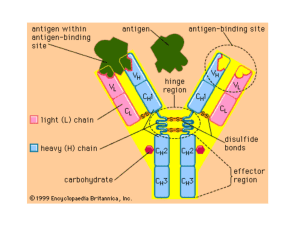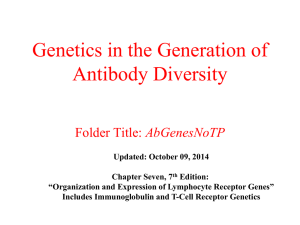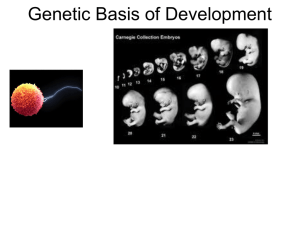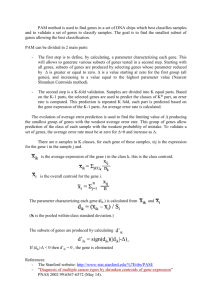Immunology
advertisement
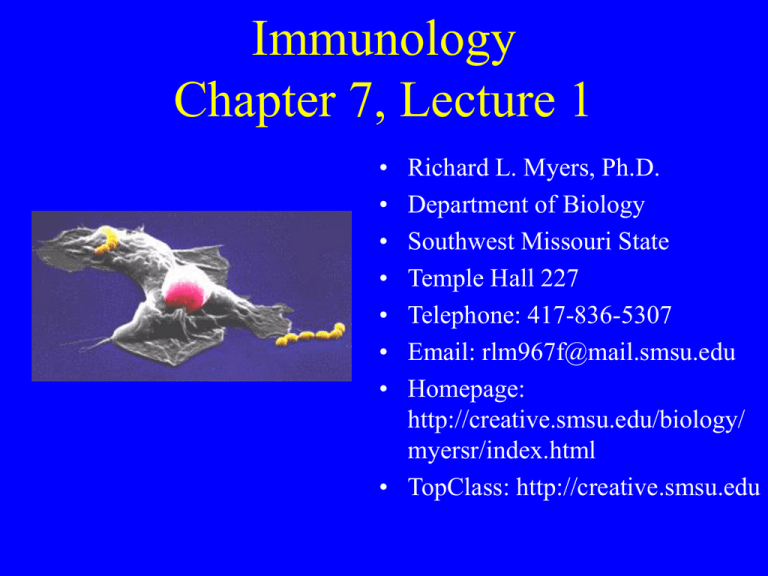
Immunology Chapter 7, Lecture 1 • • • • • • • Richard L. Myers, Ph.D. Department of Biology Southwest Missouri State Temple Hall 227 Telephone: 417-836-5307 Email: rlm967f@mail.smsu.edu Homepage: http://creative.smsu.edu/biology/ myersr/index.html • TopClass: http://creative.smsu.edu Organization and Expression of Immunoglobulin Genes • The immune system can respond to an unlimited number of antigens • Each antibody has a unique amino acid sequence in the variable region – the basis of this unique sequence lies in the organization of the immunoglobulin genes – these genes, however, have to be rearranged to become a functional immunoglobulin gene Genetic model • The model of immunoglobulin genes should address: – the diversity of antibody specificities – the variable and constant regions of antibodies – the existence of isotopes with the same antigenic specificity • Two models proposed – germ-line theory – somatic-variation therory • The model should account for the generation of at least 108 different ab – should speak to this tremendous diversity • Germ line theory – says that the genome contains the necessary genes to account for 108 different specificities • Somatic-variation theory – says that the genome contains a small number of genes – but from these a large number of antibody specificities are generated – from mutational and recombinational events Two gene model • Proposed by Dryer and Bennett (1965) – suggested that two separate genes encode a single heavy or light chain – one gene for the V region and one for the C • The important aspect is that many, many Vregion genes are in the germ line – but only single copies of C-region genes • This allows for great diversity • Results showed great diversity of antibody specificity in the variable regions Required reading Hozumi, N., and S. Tonegawa. 1976. Evidence for somatic rearrangement of immunoglobulin genes coding for variable and constant regions. Proc. Natl. Acad.. Sci. USA 73:3628 • Proof of the two-gene theory was provided by Tonegawa (1976) – cleaved DNA from embryonic and adult myeloma cells (used restriction enzymes) – separated fragments with electrophoresis – checked for hybridization with k chain mRNA probes – mRNA hybridized with two fragments from the embryo DNA – only a single fragment from the myeloma DNA hybridized • They reasoned that V and C genes undergo rearrangement as embryo develops – in embryo the V and C genes are separated by a large distance – during rearrangement they are brought together • The actual research involved digestion and electrophoresis – two bands from the embryonic DNA – one and from the myeloma DNA • Actually, there are multigene families Tonegawa’s experimental results • Myeloma cells are equivalent to differentiated plasma cells • mRNA probes were used to identify the DNA digests • Found that embryonic DNA gave two bands • Only a single band from the differentiated DNA Multigene families • Each multigene family contains “gene segments” • For example, the k and l light chain family contains an L, V, J and C gene segment • Antibody specificity is accomplished by bringing together different gene segments – VJ encodes the variable region of light chains – VDJ encodes varible region of heavy chains Example - l multigene family • Tonegawa cloned the germ-line gene and determined the nucleotide sequence – showed that the gene contains two coding regions called exons • a V segment and a J segment • these seperated by noncoding DNA called an intron • The l multigene family contains two Vl, four Jl and four Cl gene segments • The first two code the variable region and the last codes the constant region Assignment • Read Chapter 7, Organization and Expression of Immunoglobulin Genes • Review question 4 (pg 192)

